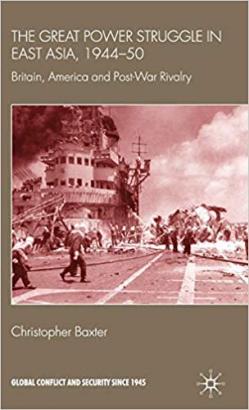The Great Power Struggle in East Asia, 1944-50, Britain, America and Post-War Rivalry

In the series Global Conflict and Security Since 1945, Palgrave Macmillan, 2009, 250 pages including endnotes, bibliography and index, ISBN: 978-0-230-20297-9, £55
Review by Sir Hugh Cortazzi
In 1945 when Lend-Lease ended, Britain was bankrupt. In the Far East the United States was dominant and the British were dependent on American good will but this was in short supply. The Americans were generally contemptuous of British fighting ability after the Singapore debacle of early 1942 and were unwilling to help the British to retrieve their commercial interests in China. They would not help Britain to recover any of its colonies even Hong Kong. The ‘special relationship’ was notable by its absence in the Far East in the years covered by this book.
This book, which deals with policy towards China, Korea and Japan up to the outbreak of the Korean War, concentrates on British attempts to reassert their interests and their frustrations in dealing with the Americans and the Australians who were frequently tiresome. It also demonstrates a lack of British realism about what could be achieved. As Baxter notes (page 26) “there was a general tendency in the Foreign Office to urge that we [the British] should undertake military commitments far beyond our manpower or our future financial and material resources.”
The American agreed reluctantly that a British force might be useful if an invasion of Japan became necessary and allowed a British naval force to join in the final stages of the fighting in the Pacific. “Preparations [page 39] for the occupation of Japan were marked by confusion whereby both the British and Americans did not understand each other’s position but assumed they did.” The Americans eventually accepted a British Commonwealth contingent in the occupation of Japan, but it could not arrive until early 1946. It was barred from any role in military government and friction between the British and the Australians detracted from its limited and doubtful political value. The Americans were so determined to ensure that the occupation was an all American affair that the members of The United Kingdom Liaison Mission in Tokyo were, at least at first, only allowed to travel outside Tokyo if they received American permission first (page 118).
British and American views differed on how to treat Japan after the war. There is a fairly widely held belief that the British wanted Japan to be treated toughly but Sir George Sansom, who had served so many years in Japan before the war and on whose “unrivalled knowledge and prestige” the Foreign Office relied greatly, produced in 1945, with Esler (later Sir Esler) Dening, a paper on policy towards Japan (page 43) which did not at that time accord with American views. Sansom argued against a long occupation and against the dismantling of industries. After the war much of Japan’s population would be unemployed and possibly starving. “Such conditions were not likely to favour the evolution of a democratic type of government in Japan. Sansom favoured instead the institution of economic controls and the necessity of working through the constitutional powers of the Emperor. Japan could not survive without the ability to trade and economic controls could therefore induce the Japanese to introduce their own reforms, ensuring good behaviour.” In this context Baxter notes page 44: “The British including Churchill who raised the matter at Yalta, had begun to question the desirability of demanding the unconditional surrender of Japan. They felt the suspension of the Emperor’s powers – ‘the most abject humiliation’ – implicit in the term unconditional surrender, would delay the war unnecessarily.” Later the British were advocates of an early peace treaty with Japan and at the official level were less anti-Japanese than the Australians. In this they were ahead of or at variance with British popular opinion which took much longer than Australian opinion to become reconciled to Japan.
In this brief review I have concentrated on a few of the interesting points which Christopher Baxter makes in relation to Anglo-American exchanges on policy towards Japan, but this book is equally revealing about policy discussions on China and Korea. Historians interested in Anglo-American relations in the immediate post-war years will find this trawl through the official archives fascinating and instructive.
As an official who served from 1951-54 under Sir Esler Dening as Britain’s first post-war Ambassador to Japan I do not think he was quote the “imperialist” Baxter describes. He was a realist. He was also crusty, tough and opinionated. He was tall and broad shouldered not stocky as Baxter describes him. He certainly had his doubts about post-war Japanese democracy, but having served in pre-war Japan he had good reason for this. He was also suspicious of American motives and good faith based on his experience as political adviser to Mountbatten as supreme commander in South East Asia and the behaviour of John Foster Dulles over the American enforced Japanese recognition of China.

